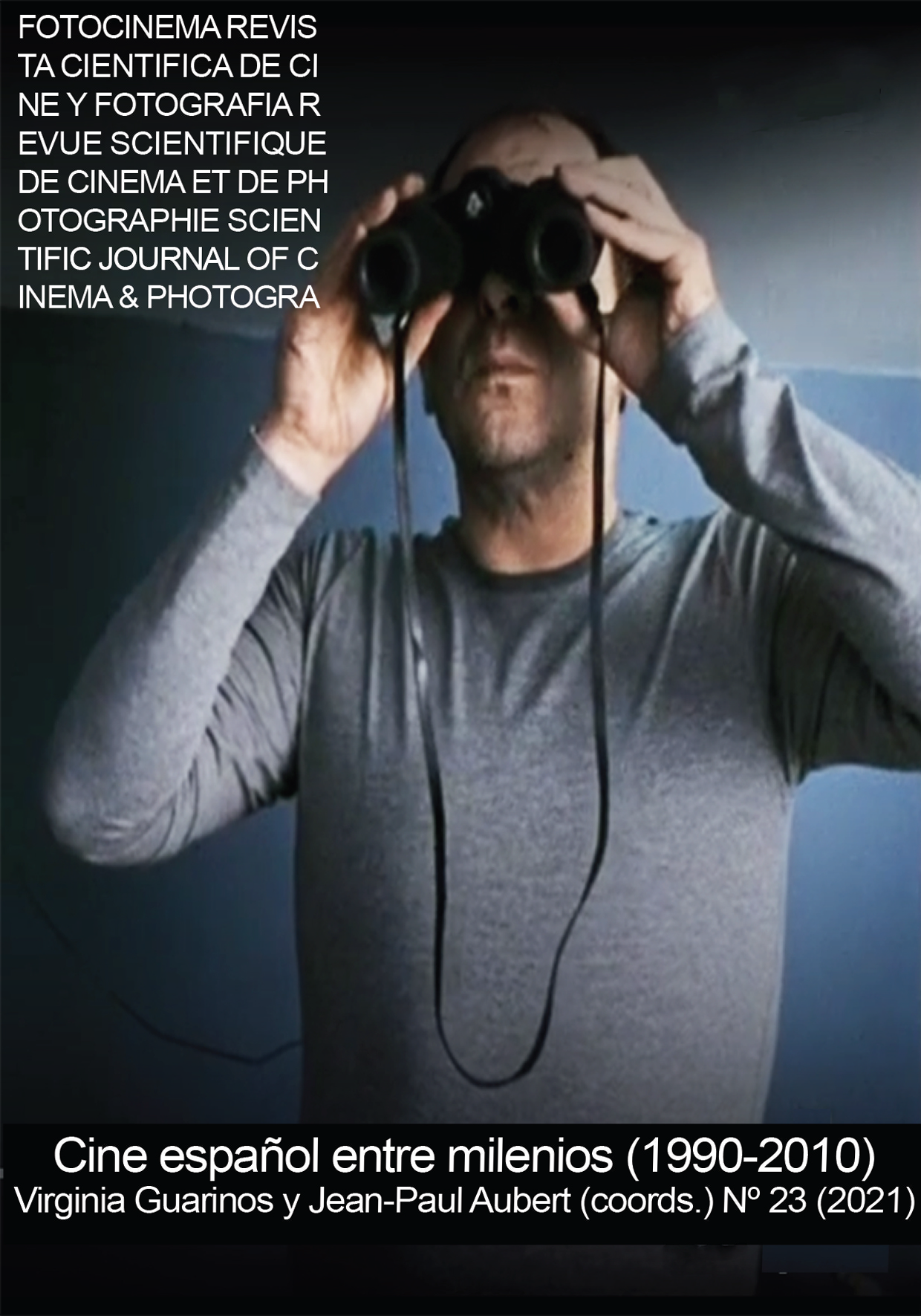Topography of the Emotions, Intertextuality, and Iconographic programs in Julieta (Pedro Almodóvar, 2016)
DOI:
https://doi.org/10.24310/Fotocinema.2021.v23i.12381Keywords:
Film, Almodóvar, Kitchen, Intertextuality, IconographyAbstract
Even when certain critical theoreticians have claimed that Julieta opens a new Almodóvar era, a less Almodóvarian period, the film writing revisits the same visual and narrative themes of previous works. The aim of this paper is to study and classify those themes, from way the story is formalized and new intertexts –sculptural, pictorical, architectural– are added, to the irruption and proliferation of the kitchen as the place-origin of an emotional, topographic map of the protagonist, as well as the shaping of unique iconographies around the idea of sex and female visage.
Downloads
Metrics
Publication Facts
Reviewer profiles N/A
Author statements
Indexed in
-
—
- Academic society
- N/A
- Publisher
- Universidad de Málaga
References
Almodóvar, P. (2016). Julieta. España: El Deseo.
Bastida de la Calle, M. D. (1996). La mujer en la ventana: una iconografía del XIX en pintura e ilustración. Espacio, Tiempo y Forma, serie VII, Historia del Arte, 9, 297-315.
Bermejo, A. G. (2016). El hombre que amaba a las mujeres. Entrevista con Pedro Almodóvar. Dirigido por, 465, 84-88.
Camarero Gómez, G. (2017). Literatura y Arte en Julieta de Pedro Almodóvar. DeSignis, 27, 45-52.
Creamer, D. (2016). Almodóvar: “Impregné Julieta de la soledad en la que he vivido estos años”. Infolibre, 21 de mayo de 2016. Recuperado de https://www.infolibre.es/noticias/cultura/2016/05/21/almodovar_quot_impregne_julieta_soledad_que_vivido_estos_anos_quot_50059_1026.html.
Fernández-Galiano, L. (2003). De la colina de los chopos al monte de las encinas. Boletín de actividades “Estudio”, 10, 4-9.
Fernández-Santos, E. (2016). Julieta, el drama más seco de Almodóvar. El País Semanal, 2060, 20 de marzo de 2016, 23-27.
Gardies, A. (1993). L´Espace au cinema. Paris: Méridien Klincksieck.
Labastida, M. (2016). Las esculturas de Miquel Navarro seducen a Pedro Almodóvar. Las Provincias, 14 de febrero de 2016. Recuperado de https://www.lasprovincias.es/culturas/201602/11/esculturas-miquel-navarro-seducen-20160211001303-v.html.
Martínez, L. (2016). Pedro Almodóvar: “El dolor exige discreción”. El Mundo, 4 de abril de 2016. Recuperado de http://www.elmundo.es/cultura/2016/04/04/56fe949c268e3ef5148b4674.html.
Moliner, M. (2001). Diccionario de uso del español, A-H, 2ª edición. Madrid: Gredos.
Poyato, P. (2015). Identidad visual y forma narrativa en el drama cinematográfico de Almodóvar. Madrid: Síntesis.
Ramón, E. (2016). Pedro Almodóvar: “Julieta refleja la soledad deliberada en la que vivo ahora mismo”. Noticias Cultura RTVE. Recuperado de http://www.rtve.es/noticias/20160404/pedro-almodovar-julieta-refleja-soledad-deliberada-vivo-ahora-mismo/1329187.shtml.
Seguin, J.-C. (2009). Pedro Almodóvar o la deriva de los cuerpos. Murcia: Filmoteca de Murcia.
Zabalbeascoa, A. (2019). Piedad Bonnett: “Escribir desde las tripas el algo femenino”. El País Semanal, 2.206, 46-51.
Downloads
Published
How to Cite
Issue
Section
License
All contents published in Fotocinema Revista científica de cine y fotografía are protected under the Creative Commons Attribution-NonCommercial-ShareAlike 4.0 International (CC BY-NC-SA 4.0) license. All about this license is available in the following link: <http://creativecommons.org/licenses/by-nc-sa/4.0>
Users can copy, use, redistribute, share and exhibit publicly as long as:
- The original source and authorship of the material are cited (Journal, Publisher and URL of the work).
- It is not used for comercial purposes.
- The existence of the license and its especifications are mentioned.
There are two sets of authors’ rights: moral and property rights. Moral rights are perpetual prerogatives, unrenounceable, not-transferable, unalienable, imprescriptible and inembargable. According to authors’ rights legislation, Fotocinema. Revista científica de cine y fotografía recognizes and respects authors moral rights, as well as the ownership of property rights, which will be transferred to University of Malaga in open access. The property rights are referred to the benefits that are gained by the use or the dissemination of works. Fotocinema. Revista científica de cine y fotografía is published in an open access form and it is exclusively licenced by any means for doing or authorising distribution, dissemination, reproduction, , adaptation, translation or arrangement of works.
Authors are responsable for obtaining the necessary permission to use copyrighted images.














13.png)



